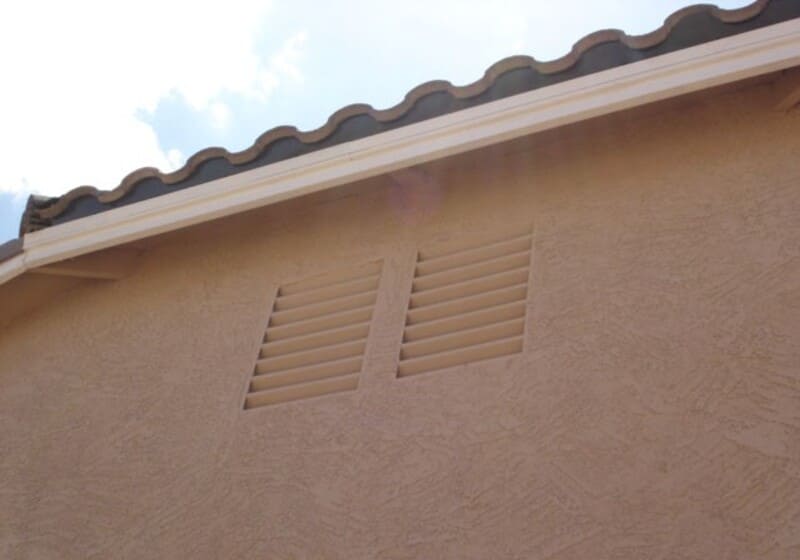We all understand the importance of a healthy roof for keeping a home in great condition. But what’s one often overlooked area that plays a huge role in a roof’s performance and efficiency? Ventilation. Here, we’ll go over how to determine whether you need better roof and attic ventilation.
Why is Good Ventilation So Important?
When we refer to roof ventilation, we’re not talking about anything complicated or mysterious. We still mean airflow, or circulation. Roof ventilation requires consistent airflow to function properly. This is typically achieved mechanically, through a power source, or naturally, using the stack effect or the wind effect.
The stack effect occurs when hot air rises and creates pressure in the attic. In order to avoid growing too hot, the hot air, known as exhaust, needs a means for escaping through the roof. Exhaust cannot escape an attic without cool, lower-pressure air entering the attic, air known as intake. Exhaust and intake work together to keep airflow steady and create a well-ventilated attic. If this circulatory system isn’t adequate, your roof could experience a number of problems.
Attic Ventilation: Telltale Signs You Need More
Ice dams
Ice buildup on a roof is known as ice damming. The presence of icicles hanging from the gutters of a home is a huge sign that its roof is not ventilating properly. Ice dams form when a roof gets too hot. Heat builds up in the attic, except in the eaves. This heat radiating through the roof causes snow to melt and begin to run off, and because the eaves are still cold, the snow freezes and turns into icicles at the gutters. But the issues don’t end there. The melted snow can back up as ice accumulates, flowing under the shingles, destroying your roof and even potentially leaking into your home.
We should also note that icicles present a very real hazard of their own. Larger icicles can cause serious injury once they loosen and begin to fall, and the weight of accumulated ice can cause gutters and awnings to collapse. All the more reason to install proper roof ventilation!
Your HVAC system is working overtime
If your HVAC system is suddenly having to pull double-duty to heat or cool your home, poor ventilation in the attic could be to blame. Exceptionally hot air in the attic can hinder your thermostat’s ability to regulate the temperature in the rest of your home. To find out if poor ventilation might be to blame, place a thermometer in your attic and monitor the temperature.
Mold is forming in the attic
Ventilation doesn’t just control temperature, it also helps control moisture. If you notice mold forming on the ceiling joints, rafters and beams of your attic, you’re probably in need of a ventilation overhaul. You’ll likely need to hire a professional to remove the mold before tackling the ventilation issue. Since inhaling mold spores can be dangerous, we don’t recommend undertaking the task yourself.
You’re noticing rust
Rust is another major indictor of moisture issues in the attic. Are you noticing those telltale brown stains on your roof’s metal components? You’ll need to hire a roofer to determine whether poor ventilation could be to blame (it probably is!).
Types of Attic Ventilation
With so many different options for ventilation, you’ll want to seek a professional opinion for advice on getting the best system for your roof’s size, age and condition. Here are several of the different ventilation devices you can choose from:
Box vents
Box vents, also known as low profile vents, louvers, flat vents or turtle vents, are static and have no moving parts. Because they are relatively small, numerous box vents are typically required to properly vent a roof. They are made of either metal or durable plastic and installed over holes cut in the roof to allow for an adequate amount of heat and moisture to escape.
Power vents
Power vents run on motors that help turn large fans to move exhaust and moisture out of the attic. Some even come with “smart” thermostats that trigger a fan to kick in when the attic reaches a certain temperature. Some are also equipped with a humidistat to kick on when humidity levels get too high. Most power vents are hardwired into a home’s electrical, but you can also find models that run on solar power. One con of power vents is that they run so quietly, it can be difficult to detect when one goes out, leaving your attic and roof at risk.
Wind turbines
Also known as whirlybirds, wind turbines rely on wind power for movement. The bulbous piece, similar in shape to a chef’s hat, spins in the wind, drawing hot air and moisture up and out of the attic. Wind turbines can be tricky—you definitely don’t want to go the inexpensive route here. Instead, opt for high-quality models with plastic bushings and permanently lubricated ball bearings.
Soffit vents
Most often composed of PVC or aluminum, soffit vents are placed in soffits and eaves. Soffit vents are not solely relied on for proper ventilation, but when combined with other types of vents, they’re an excellent option. Many homeowners choose to install them when they would like to boost ventilation and efficiency while still keeping their original system in place.
Ridge vents
Ridge vents are shaped like an open book laying facedown. Running with this analogy, the spine area of the “book,” or vent, is fitted over the entire length of the roof’s horizontal ridge to create an even distribution of temperature in the attic. Ridge vents blend more seamlessly with a home’s roof than most other types of ventilation systems, and are considered an attractive option. When combined with soffit vents, they’re also considered one of the most effective solutions out there.
Off ridge vents
Off ridge vents function similarly to box vents, but rather than being square, they’re rectangular. Because they’re small and static, you’ll need to install several of them on your roof to achieve adequate airflow.
Cupola vents
More often than not, cupola vents are decorative in nature, resembling miniature gazebos and sometimes housing weathervanes. Cupolas can, however, be functional, allowing hot air and moisture to escape from the roof. It should be noted that this type of ventilation is limited in its capabilities and should probably be combined with another type of system for the best results.
Call National Property Inspections Today for an Assessment of Your Roof
National Property Inspections can examine your home’s attic and roof and determine whether you are dealing with poor ventilation. Give your local team a call today to receive a full report complete with digital photos.



